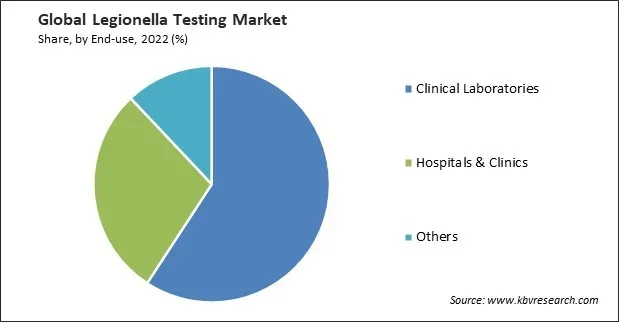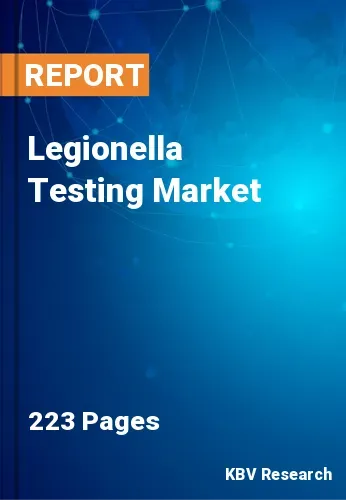The Global Legionella Testing Market size is expected to reach $578.9 million by 2030, rising at a market growth of 9.6% CAGR during the forecast period.
The sensitivity and accuracy of DFA testing in identifying Legionella antigens are well-known. This technique enables accurate identification even at low concentrations by employing fluorescent dye-labeled specific antibodies bound to Legionella bacteria. Consequently, these factors would allow direct fluorescent antibody (DFA) test segment to acquire nearly 10% of the total market share by 2030. This diagnostic method is notably effective in identifying Legionella in respiratory specimens, including sputum and lung tissues, thereby assisting in the prognosis of Legionnaires' disease. The effectiveness and dependability of the strategy can be credited with the segment's expansion. Some of the factors impacting the market are rising incidence and prevalence of pneumonia and Legionella-related illnesses, growing proportion of the aging population and lack of expertise and skilled workforce.

The significance of Legionellosis as a public health concern is growing; despite being an underreported disease, a high incidence has been consistently documented in scientific research. In addition, the disease is accompanied by substantial medical expenses. Identifying Legionnaires' disease primarily relies on detecting the serogroup one antigen of Legionella pneumophila in urine. Therefore, the market is expected to increase during the forecast period, driven by this disease's increasing incidence and prevalence, leading to a rise in demand for Legionella testing. Additionally, it is expected that the number of people aged sixty and above on a global scale will increase twofold by 2050, reaching 2.1 billion. By this time, the number of people aged 80 or older will increase by threefold, reaching 426 million. Advancing age can elevate the susceptibility to bacterial illnesses like Legionnaires' disease and pneumonia, which necessitates frequent patient visits to clinics and hospitals and ultimately results in additional medical examinations. Hence, the growing elderly population is increasing the demand in the market.
Moreover, the correlation between stagnant water in buildings and Legionella growth is a widely acknowledged reality. This was significantly exacerbated in the wake of the global COVID-19 building shutdowns, where advisories of potentially severe health risks replaced demands for building managers to implement specific intensive measures. The measures implemented to prevent the spread of COVID-19 increased the likelihood of Legionnaires' disease outbreaks. The stagnant and heated conditions created by building closures and local lockdowns provided an ideal environment for the proliferation of the dangerous Legionella bacterium in water sources. Thus, the COVID-19 pandemic positively impacted the market.
However, in some regions, the technical knowledge necessary for accurate testing needs to be improved. Locating qualified professionals with specialized training in testing protocols and techniques can take time and effort. According to the World Health Organization (WHO), there will be a 10 million health personnel shortage by 2030, with most shortfalls occurring in countries with low and lower middle incomes. Moreover, the healthcare sector needs to improve its hospital capacity. Simply put, more hospitals need to be established to meet the public's demand for valuable medical care provided by professionals. Therefore, factors like lack of workforce and healthcare infrastructure are impeding the growth of the market.
On the basis of end-user, the market is classified into hospitals & clinics, clinical laboratories, and others. In 2022, the hospital & clinics segment recorded a considerable revenue share in the market. In light of the potential for severe respiratory ailments caused by Legionella bacteria, routine testing is implemented by healthcare facilities to ascertain the absence of contamination in their water systems. Furthermore, medical facilities such as hospitals and clinics accommodate patients who are recovering from underlying health conditions, the elderly, or those who are enduring medical treatments. Healthcare facilities perform routine water system testing to ensure these populations' safety due to their heightened susceptibility to infections.

Based on type, the market is categorized into culture media, urine antigen test (UAT), polymerase chain reaction (PCR), serology, and direct fluorescent antibody (DFA) test. The urine antigen test (UAT) segment procured a substantial revenue share in the market in 2022. This laboratory test is most frequently employed to identify the Legionella bacterium in urine. It offers immediate results following sample collection. Furthermore, it is favored by individuals residing in undeveloped or developing nations due to its cost-effectiveness. These factors are anticipated to fuel the segment's growth throughout the forecast period.
| Report Attribute | Details |
|---|---|
| Market size value in 2022 | USD 281.8 Million |
| Market size forecast in 2030 | USD 578.9 Million |
| Base Year | 2022 |
| Historical Period | 2019 to 2021 |
| Forecast Period | 2023 to 2030 |
| Revenue Growth Rate | CAGR of 9.6% from 2023 to 2030 |
| Number of Pages | 223 |
| Number of Tables | 280 |
| Report coverage | Market Trends, Revenue Estimation and Forecast, Segmentation Analysis, Regional and Country Breakdown, Porter’s 5 Forces Analysis, Company Profiling, Companies Strategic Developments, SWOT Analysis, Winning Imperatives |
| Segments covered | Type, End User, Region |
| Country scope |
|
| Companies Included | QuidelOrtho Corporation, Abbott Laboratories, Merck KGaA, Bio-Rad Laboratories, Inc., Thermo Fisher Scientific, Inc., Becton Dickinson and Company, BioMerieux S.A., IDEXX Laboratories, Inc., Eurofins Scientific SE and Qiagen N.V |
| Growth Drivers |
|
| Restraints |
|
Region-wise, the market is analyzed across North America, Europe, Asia Pacific, and LAMEA. The North America region witnessed the maximum revenue share in the market in 2022. A high incidence of Legionnaire's disease diagnoses, healthcare infrastructure of international caliber, heightened awareness regarding the disease, and rigorous water testing regulations are all distinguishing features of the regional demand. Legionella testing is a priority in the United States due to the high risk of mortality associated with pneumonia among the large number of geriatric populations that are particularly susceptible to the infection. This drives the expansion of the region's demand.
Free Valuable Insights: Global Legionella Testing Market size to reach USD 578.9 Million by 2030
The market research report covers the analysis of key stake holders of the market. Key companies profiled in the report include QuidelOrtho Corporation, Abbott Laboratories, Merck KGaA, Bio-Rad Laboratories, Inc., Thermo Fisher Scientific, Inc., Becton Dickinson and Company, BioMerieux S.A., IDEXX Laboratories, Inc., Eurofins Scientific SE and Qiagen N.V
By Type
By End-User
By Geography


This Market size is expected to reach $578.9 million by 2030.
Rising incidence and prevalence of pneumonia and Legionella-related illnesses are driving the Market in coming years, however, Lack of expertise and skilled workforce restraints the growth of the Market.
QuidelOrtho Corporation, Abbott Laboratories, Merck KGaA, Bio-Rad Laboratories, Inc., Thermo Fisher Scientific, Inc., Becton Dickinson and Company, BioMerieux S.A., IDEXX Laboratories, Inc., Eurofins Scientific SE and Qiagen N.V
The expected CAGR of this Market is 9.6% from 2023 to 2030.
The Polymerase Chain Reaction (PCR) segment led the Market, by Type in 2022; thereby, achieving a market value of $234.7 million by 2030.
The North America region dominated the Market, by Region in 2022, and would continue to be a dominant market till 2030; thereby, achieving a market value of $209 million by 2030.
Our team of dedicated experts can provide you with attractive expansion opportunities for your business.

